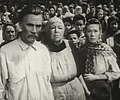The North Star (1943 film)
| The North Star | |
|---|---|
RKO Radio Pictures | |
Release date |
|
Running time | 106 minutes |
| Country | United States |
| Language | English |
| Box office | $2.8 million (US rentals)[1] |
The North Star (also known as Armored Attack in the US) is a 1943 pro-
The film is about the resistance of
In the 1950s, it was criticized for this reason and it was re-cut to remove the idealized portrayal of Soviet collective farms at the beginning and to include references to the
Plot

In June 1941,
The full brutality of the Nazis is revealed when the Germans send Dr. von Harden to use the village children as a source of blood for transfusions into wounded German soldiers. Some children lose so much blood that they die. When Dr. Pavel Kurin, a famous Ukrainian doctor, discovers this and informs the partisans, they prepare to strike back. They launch a cavalry assault on the village to rescue their families. Kurin accuses von Harden of being worse than the ardent Nazis, because he has used his skills to support them. He then shoots him. The peasants join together, and one girl envisions a future in which they will "make a free world for all men".
Cast
- Anne Baxter as Marina Pavlova
- Dana Andrews as Kolya Simonov
- Walter Huston as Dr. Pavel Grigorich Kurin
- Walter Brennan as Karp
- Ann Harding as Sophia Pavlova
- Jane Withers as Clavdia Kurina
- Farley Granger as Damian Simonov
- Erich von Stroheim as Dr. von Harden
- Dean Jagger as Rodion Pavlov
- Carl Benton Reid as Boris Stepanich Simonov
- Esther Dale as Anna
- Paul Guilfoyle as Iakin
- Tonio Selwart as German Captain
- Gene O'Donnell as Russian Pilot
- Frank Wilcox as Petrov
- Lynn Winthrop as Guerilla Girl
- Eric Roberts as Grisha
- Ann Carter as Olga Pavlova
- Ruth Nelson as Nadya Simonova
- Martin Kosleck as Dr. Richter
- Peter Pohlenz as German Lieutenant
- Robert Lowery as Russian gunner
- Loudie Claar as Woman on Hospital Cot
- Charles Bates as Patya
- Grace Cunard as farmer's wife
Criticism
The
The extent to which the film incorporated official Soviet propaganda about
Recut
The film was rereleased in 1957 under the title Armored Attack. This edited version opens with the entry of a German column marching into a village and concludes with narration praising the
In later years, the original version was made available on home video restoring segments removed for the 1957 re-release.[8]
Awards
The film was nominated for six Academy Awards:[9]
- Art Direction (Black-and-White) (Perry Ferguson, Howard Bristol)
- Cinematography (Black-and-White) (James Wong Howe)
- Music (Music Score of a Dramatic or Comedy Picture) (Aaron Copland)
- Sound Recording (Thomas T. Moulton)
- Special Effects (Clarence Slifer, Ray Binger, Thomas T. Moulton)
- Writing (Original Screenplay) (Lillian Hellman)
References
- ^ Variety (21 February 2018). "Variety (January 1944)". New York, NY: Variety Publishing Company – via Internet Archive.
- ^ a b "The North Star (1943) - Notes - TCM.com".
- ^ Murphy, Brenda (1999). "Congressional Theatre" (PDF). catdir.loc.gov. University of Cambridge.
- ^ "World War II: Soviet and Japanese Forces Battle at Khalkhin Gol - HistoryNet". 12 June 2006.
- ^ "Foreign Office's covert propaganda, Guardian 27 Jan 1978".
- ^ The Harvest of Sorrow: Soviet Collectivization and the Terror Famine, Conquest, page 321, Oxford Press, 1986; see Chapter 17 for detailed information on the efforts of pro-Soviet Westerns to help the regime cover up the true conditions on the collective farms.
- Archive.org.
- ^ "Turner Classic Movies - TCM.com".
- ^ "The 16th Academy Awards (1944) Nominees and Winners". oscars.org. Retrieved 2011-08-14.
External links
- The North Star at IMDb
- The North Star at AllMovie
- The North Star at the TCM Movie Database
- The North Star at the American Film Institute Catalog
- The North Star at Box Office Mojo
- The North Star is available for free viewing and download at the Internet Archive




